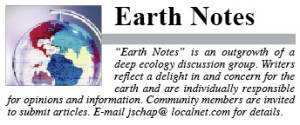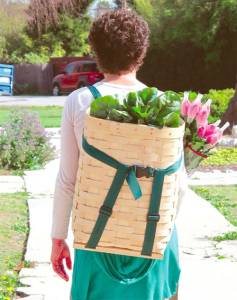Urban Green Living
Life presented me an invitation to winter in California. Yes, it happened and I write you from Culver City. Who knew?
Part of the impetus behind my hiatus from Denmark was to see if I could leave my Pleasant Mountain off-the-grid lifestyle and still have her spirit in me, finding a way to adapt with ease in an urban environment. Could I live the green lifestyle that I had grown to know and love, and live peacefully and simply amidst the contrast?
How could I slide into a conventional dwelling and still be in alignment with what I value in the way of green living?
The first uncomfortable moment came through the built-in garbage disposal. The voice of those units claim that it keeps added trash from the waste stream. My mind could not follow that line of thinking since the “garbage†put down the “disposal†was only food scraps, veggies, fruit peelings — that is compost material. I can’t see adding solids to the water treatment plant, mixing with all the other things we flush and send down drains that end up in mysterious places I know not of.
The garbage disposal led me to find out more about city composting options. Our apartment building is not paying for curbside composting, which is available for $35 a month. (How great is that?! Curbside composting!). The owners for the building complex are not willing to pay for composting.
I have looked into a host of options and settled on a quick fix. I confess, I have resorted to illegal composting activities. I noticed many residents around have the huge green bin filled with yard “waste†and compostables. Prowling around the neighborhood, compost bucket in hand, I moved quickly and stealth-like, dumping my refuse in others bins as quietly as I could. I spread the love, switching sites often, hoping to avoid an uncomfortable conversation or unexpected meeting at their bin.
It’s very satisfying to see my coffee grounds, juicing fibers and food scraps lay to rest atop their palm leaves, grass clippings and coconut shells, even without permission.
The city recycles all plastic, even wrappers and any packaging. Because of this and more, we generate very little trash compared to how much recyclable and compostable materials created, another thrill for this passionate greenie.
Los Angeles Water and Power generates 39% of its electricity from coal, 22% from natural gas, 11% from nuclear and 3% from large hydroelectric. One hundred percent of the power generated back home on Pleasant Mountain is renewable, from solar and micro-hydro power. It felt so empowering — pun intended — to be independent from non-renewable systems.
Since the prevailing winds coming into Maine are westerly, our lovely state receives its air currents, including all that is in them, from the West, as well as the mid-Atlantic states. Hello, heavy metals, dioxin, and the stew that spews from the incinerator stacks to the west and south. Sorry. It’s coming, in part, from the power I am using to generate this computer.
According to the State of Maine Inland Fisheries and Wildlife Department, there is a warning issued for eating freshwater fish from Maine due to its mercury content. Coal-fired power plants are the leading source of mercury air emissions globally, many of which are still in use in the United States. The warning for Maine fisheries is listed as follows:
• Pregnant and nursing women, women who may get pregnant, and children under age 8 should not eat any freshwater fish from Maine’s inland waters — except for brook trout and landlocked salmon, one meal per month is safe.
• All other adults and children older than 8 can eat two freshwater fish meals per month. For brook trout and landlocked salmon, the limit is one meal per week.
If this is going on in Maine and you are a reader from another state, I would check with your state government to learn about fish consumption advisories in your area. New Englanders all breathe similar air and receive comparable rain and snow. That said, I am switching to green power here in Cali, even though it costs a bit more. It doesn’t mean you will be any more likely to disregard the fish consumption warning, but I won’t be an active participant in adding to the mercury content in the clouds heading your way.
Here in California, 59% of the green power comes from biomass and waste and 41% from small hydroelectric. How odd there is no optional green power sourced from solar electric with so much sun. Most states provide an option if you would like to source your power from renewables, rather than coal, gas or nuclear. Check with the Public Utilities Commission in your state to see your options.
Whether you switch to green power or not, the less electricity used, the less needed to be generated and therefore the less the impact. I plug everything I can into power strip cords that get turned off when not in use, including the stereo and laptops. All those digital lights throughout your household add up to a lot of kilowatts per month and between all of us, that is a lot of power generated and wasted when you walk out the door, away from the machine or off to bed.
This time of year, most of the food from your plate comes from an average of 1,500 miles away, no surprise as you notice the difference in taste and texture in produce. What a difference to be in biking distance from a variety of farmers’ markets six days a week. I love the farmers’ markets because the actual farmer gets a fair price for his/her product and there is no middle layer mark up from a large retail grocer.
The last consideration for this new urban dweller is with transportation. Being able to rely on the bike for most transportation needs has been amazing, an appreciated trade off from rural Maine living. I am not saying the seven traffic lane navigation does not require keen awareness. The traffic, at times, is so intense in this city designed for its love affair with the car. Still, this human-powered mode of movement travels right along past the gridlock to the final destination, with free parking in the best location, to boot.
It’s been enriching to see how I could live in the city and still be in alignment with my environmental values. In some ways, living here has been more green than off-the-grid in Maine, being less dependent on gas-powered transportation and unable to recycle so much content and near year-round food sources grown at local farms. It seems possible to participate in green living wherever one dwells.
Jen Deraspe, founder of Nurture Through Nature Eco-Retreat Center in Denmark, has been exploring green living practices both at home and at her retreat center. For more information, go to www.ntnretreats.com



